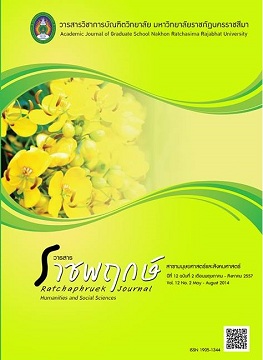Comparison of Learning Achievement and Creative Thinking of Student Learned Using the Lessons Learned on the Web and Traditional Instruction Entitled the Visual Arts and Design in Advertising Matthayomsuksa 2 Students
Main Article Content
Abstract
Web-based instruction is one model of instructional systems which provides opportunity for the student to learn at any time and places based on his or her abilities and interests. Thus this study aimed to develop web-based instruction entitled “The Visual Arts and Design in Advertising of Matthayomsuksa 2 students” with an efficiency of 80/80, to find out an effectiveness index of the developed web-based lessons in entitle“ The Visual Arts and Designin Advertising” and to compare learning achievement and creative thinking between the students who learned via the web-based instruction and those who learned via the traditional instruction. The sample used in this study were consisted of 80 Mathayom suksa 2 students from Nikhomphimaisuksa School, Phimai district in Nakhon Ratchasima province in the second semester of the academic year 2012. They were selected by the cluster random sampling technique and were assigned into two groups of 40 students: an experimental group learned via the web-based instruction and a control group learned via the traditional instruction. The instruments were (1) web-based instruction and the traditional instruction plans for 16 hours of learning, (2) a multiple-choice test on learning achievement with 30 items, with its discriminating item ranging from0.25 to 0.56, and a reliability of 0.84 , and (3) creative thinking test with item difficulties ranging from 0.58 to 0.71 with its discriminating item ranging from 6.22 - 8.55 and a reliability of 0.81. The collected data were then analyzed by the uses of a mean, a standard deviation, a percentage. Paired t-test and F-test and Hotelling were employed for testing hypotheses.
The major findings revealed as follows;
1. The developed web-based instruction had an efficiency of 83.94/81.25.
2. The developed web-based instruction had an effective index of 0.6906.
3. The students used the Web-based instruction and differences were showed by those who learned via the traditional learning method in learning achievement and creative thinking at .05 level of significance.
Article Details
References
กิดานันท์ มลิทอง. (2542). สรรค์สร้างหน้าเว็บและกราฟิกบนเว็บ. กรุงเทพฯ : จุฬาลงกรณ์มหาวิทยาลัย.
เกรียงศักดิ์ เจริญวงศ์ศักดิ์. (2545). การคิดเชิงสร้างสรรค์. กรุงเทพฯ : ซัคเซสมีเดีย.
จันทร์นิภา ดวงวิไล. (2550). การศึกษาผลการเรียนด้วยบทเรียนบนเครือข่ายอินเทอร์เน็ต รายวิชาภาษากับวัฒนธรรมท้องถิ่นที่มีต่อผลสัมฤทธิ์ทางการเรียนของนักเรียนชั้นมัธยมศึกษาปีที่ 2. วิทยานิพนธ์การศึกษามหาบัณฑิต มหาวิทยาลัยมหาสารคาม.
ฉัตรพงศ์ พีระวราสิทธิ์. (2549). การพัฒนาบทเรียนคอมพิวเตอร์มัลติมีเดียบนเครือข่ายอินเทอร์เน็ตเรื่อง ดาราศาสตร์ นักเรียนช่วงชั้นปีที่ 2. การศึกษาค้นคว้าอิสระการศึกษามหาบัณฑิต มหาวิทยาลัยมหาสารคาม.
ไชยยศ เรืองสุวรรณ์. (2551). การออกแบบและพัฒนาบทเรียนคอมพิวเตอร์ และบทเรียนบนเครือข่าย. มหาสารคาม : ภาควิชาเทคโนโลยีและสื่อสารการศึกษา คณะศึกษาศาสตร์ มหาวิทยาลัยมหาสารคาม.
บุปผชาติ ทัพหิกรณ์. (2540). “เครือข่ายใยแมงมุมโลกในการศึกษา.” วารสารสถาบันการส่งเสริมการสอนวิทยาศาสตร์และเทคโนโลยี. 15(2) : 17-21.
ปรัชญนันท์ นิลสุข. (2543). “การประเมินเว็บช่วยสอน Evaluation of Web-Baesd Instruction.” เอกสารทางวิชาการเทคโน-ทับแก้ว. 3(3) : 48-55.
ยุทธการ พราหมณ์กระโทก. (2554). การเปรียบเทียบผลสัมฤทธิ์ทางการเรียน ความคิดสร้างสรรค์กลุ่มสาระการเรียนรู้การงานอาชีพและเทคโนโลยี เรื่องโปรแกรมตกแต่งภาพ ของนักเรียนช่วงชั้นที่ 3 ที่เรียนด้วยบทเรียนแบบ Tutorial กับแบบ Problem solving. วิทยานิพนธ์การศึกษามหาบัณฑิต มหาวิทยาลัยมหาสารคาม.
วรวิทย์ ไชยวงศ์คต. (2551). การเปรียบเทียบผลสัมฤทธิ์ทางการเรียน การคิดเชิงวิพากษ์และความคงทนในการเรียนรู้ ของนักเรียนชั้นมัธยมศึกษาปีที่ 2 ระหว่างการเรียนด้วยบทเรียนบนเครือข่ายที่มีรูปแบบการเรียนร่วมมือแบบแข่งขันระหว่างกลุ่มด้วยเกมกับการเรียนแบบปกติ. วิทยานิพนธ์การศึกษามหาบัณฑิต มหาวิทยาลัยมหาสารคาม.
วิศรุต สมบัติบุญสวน. (2551). การเปรียบเทียบผลสัมฤทธิ์และทักษะการแก้ปัญหา ระหว่างการฝึกอบรมด้วยบทเรียนบนเว็บที่มีโครงสร้างแบบเรียงลำดับกับแบบใยแมงมุมเรื่องโปรแกรมระบบบริหารสารสนเทศสถานศึกษา ของบุคลากรสำนักงานเขตพื้นที่การศึกษาหนองคาย เขต 3. วิทยานิพนธ์การศึกษามหาบัณฑิต มหาวิทยาลัยมหาสารคาม.
สรรรัชต์ ห่อไพศาล. (2544). “นวัตกรรมและการประยุกต์ใช้เทคโนโลยีเพื่อการศึกษาในสหัสวรรษใหม่ : กรณีการจัดการเรียนการสอนผ่านเว็บ.” วารสารศรีปทุมปริทัศน์. 1(2) : 93-102.
สุรชัย กุลทอง. (2550). ผลการด้วยบทเรียนบนเครือข่ายแบบ NTeQ (Integrating Technology for Inquiry) เรื่อง สิ่งแวดล้อมศึกษา ที่มีต่อผลสัมฤทธิ์ทางการเรียนและเจตคติต่อการอนุรักษ์ธรรมชาติและสิ่งแวดล้อมของนักเรียนชั้นมัธยมศึกษาปีที่ 1. วิทยานิพนธ์การศึกษามหาบัณฑิต มหาวิทยาลัยมหาสารคาม.
สุรเดช มูลจันที. (2550). การเปรียบเทียบผลการเรียนรู้เรื่อง คอมพิวเตอร์กับบทบาทสารสนเทศของนักเรียนชั้นมัธยมศึกษาปีที่ 2 ที่เรียนด้วยบทเรียนบนเครือข่ายกับวิธีสอนแบบปกติ. วิทยานิพนธ์การศึกษามหาบัณฑิต มหาวิทยาลัยมหาสารคาม.
สุวิทย์ มูลคำ. (2550). กลยุทธ์การสอนสร้างสรรค์. พิมพ์ครั้งที่ 4. กรุงเทพฯ : ภาพพิมพ์.
อารี พันธ์มณี. (2543). ความคิดสร้างสรรค์. กรุงเทพฯ : ต้นอ้อ.


